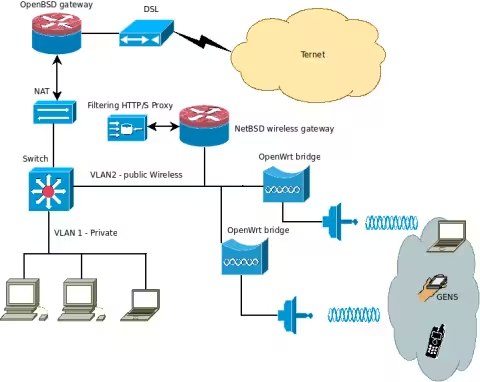Setting up a WiFi Hotspot
Introduction
One of the things, if not THE thing I was dying to do in my new apartment, was to set up a real hotspot, as I explained in the two news posts below. Well, it’s now up and running. I don’t know yet if I’ll make a full article about it or if I’ll just give tips as I go along, but in the meantime, here’s what it looks like:

Installation and configuration
Two OpenWRT devices configured as simple bridges allow guests to connect to the VLAN dedicated to the public wireless network:
# /etc/config/wireless
config wifi-device wifi0
option type atheros
option disabled 0
option mode 11b
option distance 10000
option diversity 0
option txantenna 1
option rxantenna 1
option channel 6
config wifi-iface
option device wifi0
option ifname ath0
option network lan
option mode ap
option ssid Empire-Network
option encryption none
option txpower 18
# /etc/config/network
config interface loopback
option ifname lo
option proto static
option ipaddr 127.0.0.1
option netmask 255.0.0.0
config interface lan
option ifname eth0 ath0
option type bridge
option proto static
option ipaddr 192.168.200.253
option netmask 255.255.255.0
A DHCP server provides an IP in the appropriate subnet. A simple pf rule redirects all HTTP requests to a captive portal that explains to guests what information to enter in their browser to be able to use HTTP, HTTPS, and FTP (note that so far, only one out of about 30 has managed to complete this highly technical operation…). Some QoS rules ensure that guests don’t consume all my bandwidth:
# /etc/pf.conf
int="fxp0"
table <empire_guests> { 192.168.200.0/24, ! 192.168.200.254, ! 192.168.200.253, ! 192.168.200.252 }
altq on $int cbq bandwidth 28Mb queue { empirenet_in, empirenet_out }
queue empirenet_in bandwidth 2Mb priority 1 cbq(default)
queue empirenet_out bandwidth 128Kb priority 7
rdr on $int inet proto tcp from any to <empire_guests> port www -> 127.0.0.1 port 80
pass in on $int from any to <empire_guests> queue empirenet_in
pass out on $int from <empire_guests> to any queue empirenet_out
The user then goes through Squid, and their activity is filtered by squidGuard, in which I’ve blocked the categories !aggressive !violence !hacking !ads !porn !warez !suspect. I apply port-based access lists on the switch that only allow HTTP, SSH, and DHCP protocols.
[...]
ip access-list extended wifiout
permit ip any host 192.168.200.254
permit tcp any any eq http
permit udp any any eq bootps
permit tcp any any eq ssh
[...]
interface e 18
ip access-group wifiout in
[...]
Everything is graphed by Cacti, notably thanks to the dhcpd-snmp extension of Net-SNMP and the associated Cacti template.
If you’re in the 17th arrondissement of Paris, look for the SSID “Empire-Network” :)
Resources
Last updated 23 May 2008, 07:05 CEST.